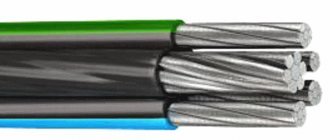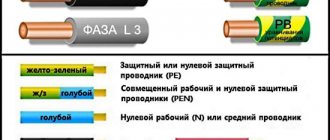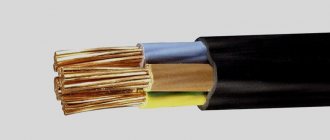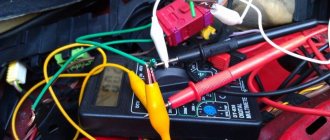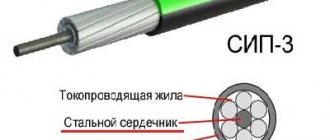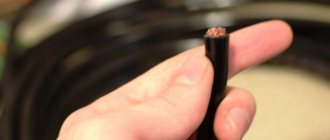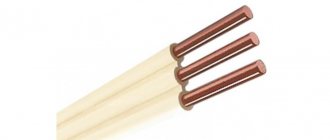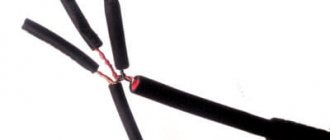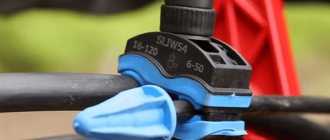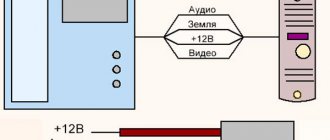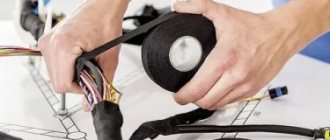Electrician in the house
Encyclopedia about electricity from A to Z
Masters catalog
Find the best master or company in your city
Factory packaged wires
The operating principle of most electrical machines is based on the interaction of magnetic fields that are created using coil windings. Coils are an essential part of generators and transformers, and almost all radio-electronic devices.
To create them, winding wire is used. Let's talk about its types and brands, features and applications of different types.
- Why do you need knowledge of the features of winding wires?
- Classification of wires Conductor material
- Section geometry
- Insulation material
- Paper insulation
- How to choose a wire for a winding or coil
Why do you need knowledge of the features of winding wires?
Reels with small footage for retail sale to home craftsmen
Many people make repairs with their own hands, or assemble homemade structures. Often a burnt-out electric motor is rewound independently, electromagnets (solenoids), transformers, magnetic antennas and inductors for radio-electronic devices are wound. In this case, only the diameter of the wire and the number of turns are taken into account (these characteristics can be found in reference books, repair manuals, or calculated).
- But often not only they are important, but also the type of wire - and it may not be indicated. For example, the required number of turns, due to the fact that a brand with a thicker insulation layer was chosen, may simply not fit into the dimensions of the coil.
- The type of wire is also important for the reliability of the device, and even its safety; if you choose it with insufficient insulation resistance or not intended for operation at such a temperature, an interturn short circuit or breakdown may occur.
- If the first will only lead to failure of the device, then the second, if safety measures are not followed (grounding, zeroing, etc.), can be life-threatening.
In addition to the above, the price of wires with the same electrical characteristics, but different types, can vary significantly. Knowing this, you can save on material.
Why overpay for a wire designed to operate at elevated temperatures and humidity for a transformer, in which the widely used PEV brand can work perfectly.
Structure of the PELSHO cable
- The single-wire conductor can be copper or aluminum with a round or rectangular cross-section.
- Enamel, paper, fiberglass, plastic insulation.
PELSHO cable sections
Technical characteristics of the PELSHO cable
| Operating temperature, °C | -60 to +105 |
| Lifetime | is not limited |
Scope of application of the PELSHO cable
Winding wires are a special type of cable products used for winding electrical devices and mechanisms operating from a network source. These designs are characterized by resistance to high temperatures and the possibility of prolonged heating without compromising functionality. One of these wires is the PELSHO winding cable, which any Russian customer can buy. This product is reliable, has good technical performance, and is durable in use subject to all operating conditions.
Explanation of the abbreviation for PELSHO wire
- P – wire
- EL – enamel insulation on an oil-resistant basis
- SHO – winding made of one layer of natural silk
Description of the composition of the PELSHO wire
The product is based on a current-carrying core, which is responsible for supplying electricity to the connected mechanisms. Most often, the core is made of copper, but there are other options, including aluminum, an alloy of silver and constantan. The choice of copper by the majority of manufacturers is due to the fact that this metal has the best electrical conductivity, while being flexible and affordable. Only aluminum wire is cheaper than copper, but it is not so ductile, and its current loss in some cases is as much as 50–60%.
The protective insulating layer consists of enamel on a varnish base. This material is resistant to mineral oils and other chemicals and can withstand prolonged exposure to high temperatures. The enamel has excellent strength, which allows it to withstand intense mechanical loads.
Another insulating layer of the PELSHO winding wire consists of natural silk fiber. Silk has hygroscopic properties, so the network can be laid even in areas with high air humidity.
Technical characteristics and application of PELSHO wire
- Operating temperature range – from -60 to +105 degrees
- Laying at a temperature not lower than -15 degrees (without preheating)
- Climatic version – from 2 to 5
- Shelf life – at least 12 months
- Nominal service life - unlimited
- High resistance to wear and external damage during operation
- Section diameter – from 0.05 to 1.5 cm
Scope of use
The description of the PELSHO cable always states that this design can be used as a winding for electrically powered mechanisms and machines. The product is used in the radio engineering, aviation and space industries. Can be used during blasting operations, in conditions of regular or constant vibration.
Wire classification
Special nichrome wire for windings
Wires are classified according to several criteria.
Conductor material
This:
- Copper is the most widely used.
- Aluminum - due to higher resistivity than copper, they are used less frequently. But, recently, their use has been expanding, since aluminum is cheaper.
- From resistance alloys (nichrome and the like) - used for some devices.
Section geometry
Rectangular wires
Wire cross-sections are round and rectangular. The latter are used when it is necessary to pass a large current through a conductor, for conductors with a large cross-sectional area. For cooled coils, hollow wire is used.
Insulation material
Various materials are used - from paper and natural fibers to glass. Often several layers are used, for example: paper and enamel.
For insulation, not only dielectric properties are important, but also mechanical strength and thickness. The smaller it is, the more turns can be laid in a coil for a given wire diameter.
Selecting wire cross-section for current
How to calculate the cross-section of a wire if only the current strength (I) is known? This calculation is made less frequently, but it is worth paying attention to this too.
It is necessary to find out what wire cross-section to use for an electric motor connected to a voltage (U) of 220 V. Its power (P) is not known.
Briefly connect the electric motor to a 220 V network and measure the current (I) using electric clamps. For example, the current is 10 A.
You can use a formula that can quickly calculate everything:
From this formula we find power (P):
P = 10 × 220 = 2200 W = 2.2 kW
So, the power of the electric motor is 2.2 kW and the power consumption is 10 A. Using Table 2, we determine the cross-section of the wire, “Copper cores of wires and cables” > “Voltage 220 V” > “Current, A”. The first number starts with 19, and we have 10 A, opposite this number the wire cross-section is 1.5 mm². For our example, 1.5 mm² is more than enough.
Wire marking
Label with markings on the factory packaging of Ukrainian-made wire
They are marked with several letters and numbers, after the mark they usually indicate the cross-sectional diameter.
Attention. The diameter of the wire cross-section is determined by copper, so if you want to find out by measuring it, for example, with a micrometer, first remove the insulation.
For copper wires, the first letter is P (wire), aluminum wires are designated AP, and resistance alloys have their own designations. Then comes the designation of the insulation, usually by the initial letters of the materials of its components and the number of layers. For rectangular wires, the letter P (rectangular) is placed at the end, followed by a hyphen that distinguishes the types.
For example, PELSHKO - Wire Enamel Lacquer Silk Nylon Single, copper wire coated with varnish enamel, and additionally insulated with one layer of nylon silk. If there were two layers, then the letter D (double) would appear.
Next, we will consider in more detail all common types of insulation, without covering its rare types, usually intended for work in special conditions or special devices.
Attention. We present the labeling generally accepted in our country. It may differ for imported wire, to the point that each company has its own designation system. Therefore, when buying material from foreign manufacturers, you need to study the passport characteristics and select analogues according to operating conditions.
Paper insulation
Paper Insulation Rectangular Wire for Transformers
Due to their low dielectric properties, such wires are usually used in low-voltage devices and combined with other materials. Special paper is used for their production: cable or telephone.
Paper-insulated winding wire is widely used for oil-filled transformers. In them, the oil not only cools the windings, but increases the resistance to breakdown. An example of APB marking is aluminum winding wires in paper insulation.
Attention. The letter B can denote not only paper but also cotton yarn, which is very similar in characteristics to it.
Fiber and film insulation
Natural silk insulation
Various fibers and films are used for it: both natural (cotton, silk) and synthetic. They withstand greater mechanical loads than winding wires with paper insulation, but are inferior in thickness.
They are most often made by multi-layer winding of fibers on a conductor. An option is also possible when the threads are intertwined - this method is used for large diameters. The film is applied by passing through a bath of liquid insulating material. To improve properties, such insulation is combined with enamel or the same paper.
The winding material designations are as follows:
- asbestos - A;
- arimid - Ar;
- cotton - B;
- lavsan - L;
- nylon - K;
- trilobal - Kp;
- plastic - P;
- glass - C;
- glass with polyester - SL;
- fluoroplastic (Teflon) - F;
- natural silk - Sh.
Example: PBBO wires are winding wires with paper insulation, the layer of which is reinforced with a layer of wound cotton yarn.
Enamel
Enamel as insulation
These wires are the most commonly used. Almost all windings of transformers and inductors in electronic devices are wound with them. The photo at the beginning of the article shows coils of these wires in factory packaging.
They are used in widely used electromechanical devices. Almost every standard motor, generator, or contactor we encounter that is not designed for special applications will likely have coils that use enamel insulated winding wires.
The advantage of this type of insulation is the small thickness of the protective layer and ease of application. It is enough to dip the wire into the enamel. The insulating material is designated by the letter E, followed by the next letter indicating the type of enamel.
- Polyamide - An.
- Viniflex - V.
- Polyamidofluoroplastic - I.
- L - oil-based varnish-resistant enamel. The most common type. This is not a reservation; it means resistance specifically to the effects of electrical varnish, or rather the solvents included in its composition. The fact is that the coils are impregnated with varnish after winding for additional protection and mechanical fixation of the conductors. The enamel should not lose its properties after this operation.
- Freon-resistant polyester cyanura-timide - F. Winding wires with enamel insulation of this type are used for windings cooled by freons.
- Polyester - E.
- Polyetherimide - EI.
Wires are also distinguished by the maximum temperatures that their coating can withstand without losing their properties. They are divided into groups (index) - 105, 120, 130, 155, 180, 200, 220 and above °C, respectively.
What other insulation features may be indicated in the labeling?
In addition to the type of insulation material and the number of its layers, the marking may additionally indicate:
- The fact that it is reinforced - U.
- Refined - I.
- Covered with a layer of additional varnish on the surface - L.
Winding wires. Types and labeling. Insulation and application
Winding wires are used for the production of windings for transformers, electric motors, electromagnetic relays and many other mechanisms.
A winding wire, unlike other types of conductors, has as its main parameter the diameter of the current-carrying core, and not its cross-section. There is a very thin wire for the windings, and has a negligible layer of insulation. The finest winding conductors are produced using a special production technology for particularly thin conductors and electrical insulation materials.
For a long time, winding wires were made exclusively of copper. Today, aluminum and other alloys with significant resistance are often used for them. Aluminum allows you to save expensive and scarce copper.
Classification
Winding wires are classified according to insulation material, cross-sectional shape and core material.
Insulation material
The winding wire is manufactured with the following types of insulation:
- Fibrous.
- Enamel.
- Combined.
Fibrous
Wires with fiber insulation have increased mechanical strength. The thickness of the fibrous insulation is quite large, and can reach up to 0.4 mm per side. The chemical resistance and moisture resistance of such wires is low.
Fiber insulation of wires used for rewinding electric motors and producing oil transformer coils may include paper, cotton fabric, glass, asbestos fibers, lavsan, and silk. These fibers and fabrics are layered like a woven stocking.
Enamel insulation
The materials used for enamel insulation are viniflex, metalvin, silicone base, polyether terephthalic acid, polyurethane.
The winding wire, coated with special enamel, has electrical strength, resistance to moisture, and aggressive chemicals. A feature of enamel winding wires is the very small thickness of the insulated layer (the largest thickness is 0.09 mm). The enamel strength of PEL wire is low; such wire is used only for windings of coils operating in a stationary state.
High-strength enamel wire PETV, as well as PET-155, is used for windings of electric motors with a power of up to 100 kilowatts. Enameled wire, grade PET-155, is used for the production of a new series of electric motors; the strength of its insulation allows the wire to be wound on automatic machines. Enameled wires also have high heat resistance and can withstand temperatures up to 155°C.
Combined
The winding wire with combined insulation in its parameters is in an intermediate position between the two types of wires considered. The combined type of insulation includes several layers. The outer covering is usually made of a fibrous material, and the inner covering is enamel. For example, PELSHO wire means: copper winding wire with insulation made of silk and varnish enamel.
If the conductor is impregnated with heat-resistant varnish and covered with fiberglass, then its marking contains the letter “K”. This type of wire has become popular due to its high reliability, and is used for electric motors of hoisting and transport mechanisms, including shipbuilding cranes.
Section shape
Winding wires come in two cross-sectional shapes:
- Round.
- Rectangular.
Round wire cross-section is used in various fields. This wire has high strength and electrical characteristics.
The dimensions of rectangular wire sections are standardized. This wire is often used for transformer windings. The thickness of the rectangular reins reaches up to 5.9 mm and the width up to 14.5 mm.
The ratio of these sizes may vary. There are some disadvantages expressed in the use of flat winding wires. When it is wound onto a coil, there is a high probability of damaging the insulation, and also, with very small cross-sections of the wire, it is visually difficult to distinguish the smaller side of the section from the larger one.
In any winding, an important element is the turn of the conductor around the core. The required wire cross-section is selected based on the current power. Round wire is generally used for light loads, while rectangular wire is used for higher loads.
Conductor material
Most winding wires are made from the following materials:
Copper winding wires make up the majority of all wires produced. They have low resistivity and significant weight. The cost of copper wires is high.
Recently, instead of copper wires, aluminum wire has been used for windings, which is much lighter in weight, has a lower cost, but has a higher resistivity compared to a copper conductor.
Marking
To designate a wire, it is marked, which indicates the material of the core and insulation.
- At the beginning of the designation is the letter “ P ” for copper wire, and means “wire”.
- To distinguish aluminum and copper wires, there is a letter “ A ” at the end of the marking, for example, PEVA.
- If the core is made of an alloy that has a high resistivity, then the designation contains additional letters, for example, NH - nichrome, M - manganin, K - constantan.
- M ” is used to designate a soft conductor T ” is used for a hard conductor. PEMT wire is copper wire made of hard wire, and PEMM is made of soft wire.
Letters for insulation
- EM – high-strength polyvinyl enamel.
- EL – oil base.
- EV – high-strength polyvinyl acetate enamel.
- L – lavsan.
- Ш – natural silk.
- B – cotton yarn.
- O – one layer.
- C – fiberglass.
- ShK - nylon.
- D – two layers.
High Frequency Winding Wire
Litz wire with fiber insulation
- In addition to standard single-core wires for coils operating at high frequencies, special wires are used - Litz wires.
- The fact is that high-frequency currents pass only along the surface of the conductor. The resistance in this case does not depend on the cross-sectional area of the conductor, but on the length of its perimeter.
- In order to maximize it, the winding wire is made stranded - from a bundle of thin conductors with a diameter of a fraction of a millimeter. The grafting is also carried out in a special way. Such wires are designated by the letter L.
We list the most common brands of such wires:
- Power lines and power lines - a bundle of conductors does not have additional general insulation.
- LESHO and LESHD - wrapped in silk in one and two layers, respectively.
- LEPKO - with a fibrous nylon covering.
Attention. It is difficult to remove the insulation from such wires mechanically due to the thin wires, so before tinning them, special etching compounds are used for desoldering. Only power lines and power lines can be soldered immediately - their insulation is removed when heated with a soldering iron tip.
Winding wire replacement table
The table below is used by professional electric machine wrappers. If for some reason it is not possible to use the required winding wire diameter, then using this table, you can replace it with other winding wire diameters, two or more.
Ways to use the table:
Method No. 1
Let's assume that we need a winding wire with a diameter of 1.25. In the column to the right of the diameter (S mm 2) its area is written, which is equal to 1.23 mm 2. Let's assume that we decide to wind in two wires (“in two cores”). To do this, you need to divide the cross-sectional area of 1.25 by the number of wires.
1.23 mm 2 / 2 = 0.62 mm 2
Now we look for a suitable number in the area column. I note that the error can be +/-5%, that is, the wire we need can be from 0.59 mm 2 to 0.65 mm 2. We find in the area column 0.636 mm 2. In the diameter column (to the left of the area column) we see that this area corresponds to a wire of 0.90. This means that a 1.25 diameter wire can replace a double 0.90 wire.
Method No. 2 “Addition of areas” As the professionals say, “You can wind at least a hundred different wires, the main thing is that they all fit into the groove.” The essence of this method is simple, the number of wires does not matter, it is important that the sum of their areas coincides with the one being replaced. Let's take the already known 1.25 with an area of 1.23 mm 2. We are required to use the table to find either 2 or several wires, whose sum of their areas was approximately 1.23 mm 2 with an error of +/-5%, i.e. 1.17-1.29 mm 2. Find these numbers and add them up
0.159 mm 2 + 0.353 mm 2 + 0.709 mm 2 = 1.221 mm 2
In the diameter column (to the left of the area column) we see that this area corresponds to wires with diameters of 0.45, 0.67 and 0.95. All these wires together replace the 1.25 wire
Note: If you have a wire not listed in the table and you can measure its diameter, then you can calculate its area using this service .
Source
Requirements for winding wires
The insulating layer covers the winding wire evenly. Coils, reels or drums are used for transportation, depending on the brand and size. The winding is tight, uniform, and not tangled. According to the brand and size of the wire, the corresponding number of segments in the bay. During transportation, the insulating layer needs protection. The weight of the container with the wire does not exceed 80 kg. All parameters are indicated on the labels attached to the reels or reels. Should be stored in warehouses with low humidity.
§ 18. Winding wires with enamel insulation
Copper and aluminum winding wires are used for the manufacture of windings of electrical machines, devices and instruments. Winding wires are produced with enamel, fiber, film, and also with enamel-fiber insulation *.
* Extensive work on obtaining and researching new types of winding wires was carried out by prof. V. A. Privezentsev and his employees.
Enamel insulation has the smallest thickness (0.003-0.065 mm) compared to fibrous and film insulation of winding wires. This allows you to lay a larger number of wires in the same volume of winding and thereby increase the power of an electrical machine or apparatus. Therefore, enameled wires are the most promising among winding wires. The enamel insulation on a wire is a flexible varnish coating obtained by hardening a layer of varnish applied to the wire. Varnish is applied to the wire using enameling machines. In table 6 and 7 show the main range of copper and aluminum wires with enamel insulation. It should be noted that the heat resistance of enamel insulation on aluminum wires is on average 6-8°C higher compared to the corresponding enamels on copper wires. This is explained by the lesser catalytic effect of aluminum on the organic enamel coating. Due to the need to save conductor copper, the range of aluminum winding wires will increase. Of practical interest are winding wires with high-strength enamel coatings based on polyvinyl acetal resin (PEV-1 and PEV-2 wires) and wires with a high-strength enamel coating based on polyurethane resin (PEVTL wires) *. The latter are characterized by increased heat resistance (up to 120° C) and the ability to be serviced without preliminary cleaning of the enamel insulation. The enamel insulation of GEVTL wires is thermoplastic and melts at temperatures of 160° C and above. In molten form, enamel insulation based on polyurethane resin acts as a flux and facilitates soldering of wires with tin-lead solders. PETV wires enameled with lavsan-based varnish (polyester varnishes) have higher heat resistance** (130° C) and good electrical insulating properties.
*PEVTL - wire coated with enamel of increased heat resistance, tinned.
** Heat resistance - the ability of an electrical insulating material to withstand a given maximum temperature for a long time without noticeably changing its basic properties
Copper winding wires with enamel insulation
| Wire brand | Core diameter without insulation, mm | Wire characteristics | Insulation layer thickness (on one side), mm | Areas of use |
| PEV-1 | 0,02—2,44 | Wire insulated with high-strength Viniflex enamel | 0,004-0,025 | Windings of electrical machines, apparatus and instruments operating at temperatures not exceeding 105° C |
| PEV-2 | 0,05—2,44 | The same, but with a thicker layer of enamel insulation | 0,006-0,035 | Same |
| PEVTL-1 | 0,02—1,56 | Wire insulated with high-strength enamel with increased heat resistance | 0,003-0,035 | Windings of electrical machines, apparatus and instruments operating at temperatures up to 120" C. Tinning and soldering of wires without stripping the insulation and without the use of fluxes |
| PEVTL-2 | 0,02—1,56 | The same, but with thicker insulation | 0,005-0,04 | Same |
| PETV | 0,06—2,44 | Wire insulated with high-strength polyester enamel with increased heat resistance | 0,005-0,04 | Windings of electrical machines and devices operating at temperatures up to 130°C |
| PNET—IMID | 0,1—2,44 | Nickel-plated wire, insulated with high-strength heat-resistant polyimide enamel | 0,012-0,05 | Windings of electrical machines and devices operating at temperatures up to 220“ C |
Table 7 Aluminum winding wires with enamel insulation
| Wire brand | Core diameter without INSULATION, mm | Wire characteristics | Insulation layer thickness (per side), AIM | Areas of use |
| PEVA | 0,08—2,44 | Wire insulated with high-strength Viniflex enamel | 0,01—0,06 | Windings of electrical machines, apparatus and instruments operating at temperatures not exceeding 110° C |
| PETWA | 0,14—2,44 | Wire insulated with high-strength polyester enamel with increased heat resistance | 0,02—0,07 | Windings of electrical machines, apparatus and instruments operating at temperatures up to 130°C |
| PETA | 0,08—2,44 | Wire insulated with high-strength heat-resistant polyimide enamel | 0,02—0,06 | Windings of electrical machines and devices operating at temperatures up to 220° C |
Wires enameled with high-strength polyimide-based enamel (PNET-imide brand) have the highest heat resistance (220° C). Windings made of wires with enamel insulation require impregnation with electrical insulating varnishes, just like windings made of wires with fiber insulation. The fact is that in a thin layer of enamel insulating coating there is always a small number of through holes (pinpoint damage), caused by imperfect wire enameling technology and the presence of burrs on the wire. On a wire length of 1 m there can be from 5 to 15 point damage. There are fewer pinhole damage on larger diameter wires. The most important characteristics of enameled wires are: elasticity and breakdown voltage of enamel coatings. Other characteristics worth noting are: resistance to thermal shock, adhesion of enamel insulation, its thermoplasticity and mechanical strength during abrasion. Here we will look at the first two characteristics. The elasticity of the enamel coating on wires with a diameter of up to 0.35 mm is determined by the smooth stretching of the wire until it breaks. In this case, the enamel film should not crack. For larger diameter wires (from 0.35 mm and above), the elasticity of the enamel coating is determined by winding the wire onto a steel rod, the diameter of which is two or three times the diameter of the bare wire (without enamel). For example, a PEV-1 wire with a diameter of 0.96 mm is wound onto a steel rod with a diameter of 3X0.96 = 2.88 mm. In this case, a tensile force of a certain magnitude (0.5-1 kg) is applied to the wound wire.
Ten turns of the wire being tested should be tightly laid on the steel rod. In the case of high-quality enamel insulation, it should not crack or peel off from the surface of the wire. The described test of enamel insulation for elasticity is carried out at room temperature and at high temperatures: 125 ° C and above - depending on the brand of wire. The breakdown voltage of enamel insulation is determined on two pieces of wires 125 mm long twisted (twisted) together. The number of twists over a length of 125 mm is set depending on the diameter of the wire (Table 8). As the wire diameter increases, the number of twists decreases accordingly. Twisting of two pieces of enameled wires is carried out in a special machine at a tension of 0.5 kg/mm2 (4.9 i/mm2) for aluminum wires and 1 kg/mm2 (9.8 i/mm2) for copper wires. In table Figure 8 shows the lowest values of breakdown voltage for two layers of enamel on twisted sections of wires. Table 8 Breakdown voltage of wires with enamel insulation
| Wire diameter (copper), mm | Number of twists per length 125 mm | Lowest breakdown voltage of twisted wires of various brands, V | |||
| PEV-1 | PEV-2 | PEVTL-1 | PETV | ||
| 0,06—0,07 | 40 | 400 | 500 | 350 | 450 |
| 0,08—0,09 | 40 | 500 | 700 | 400 | 550 |
| 0,10-0,14 | 33 | 600 | 800 | 500 | 700 |
| 0,15—0,20 | 33 | 700 | 900 | 600 | 800 |
| 0,27—0,35 | 23 | 900 | 1250 | 800 | 1200 |
| 0,44—0,53 | 16 | 1000 | 1350 | 850 | 1200 |
| 0,55—0,83 | 12 | 1100 | 1500 | 1000 | 1500 |
| 0,86—1,35 | 8 | 1300 | 1800 | 1200 | 1800 |
| 1,40—1,50 | 6 | 1500 | 2000 | 1400 | 2800 |
| 1,56—2,10 | 4 | 1500 | 2000 | 1400 | 2000 |
